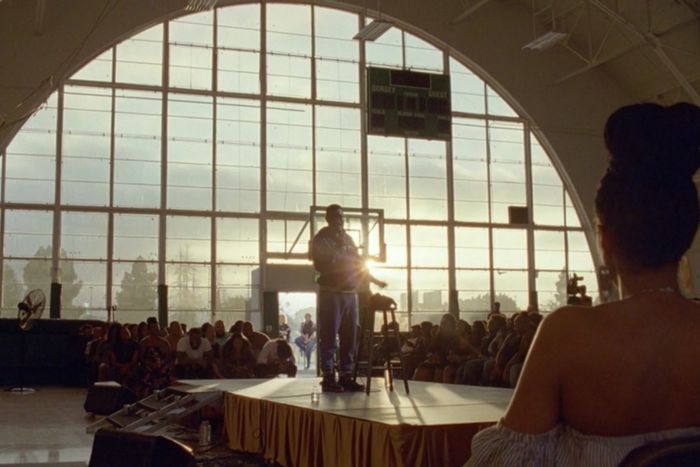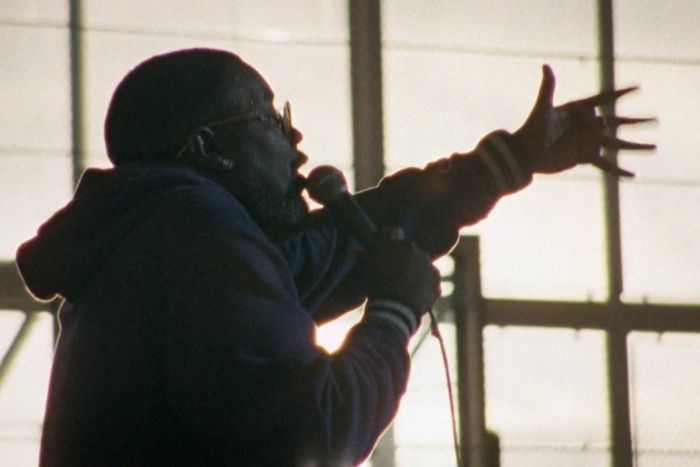
Comedy specials can have a frictionless blankness to them. Sure, the material may be highly topical — jokes about presidents, jokes about recent cultural references, jokes about contemporary political flash points. But so often, the look of them is deliberately unremarkable. There’s a theater and a stage, a curtain, a stool, a wide shot, a close-up, maybe some audience reaction images. You can locate yourself roughly in time based on fashion choices, but the crowd could still be from anywhere. The potential upside is universality. This could be happening in your town! But universality is rarely the result of generality.
Live in Crenshaw, Lil Rel Howery’s 2019 HBO special directed by Jerrod Carmichael, is the opposite. The guiding principle behind every choice is to allow the special to reflect and showcase a particular place at a precise moment in time. The direction of the special not only lingers and focuses on specificity, it insists that those elements are necessary context for Howery’s work. It is not comedy in a vacuum, on a random stage in a random city. It’s Lil Rel Howery, standing on a platform in the middle of a high-school gymnasium, in a predominantly Black neighborhood in Los Angeles.
No school gym has ever looked more like a gym than the gym in this special. Howery enters through a door on the side, which is propped open by a large trash bin. As he performs, a green exit light glows from one angle, and basketball hoops loom in the background of another. Massive metal-caged fans stand on the sides, although they’re not turned on — Howery, wearing a purple sweatsuit, has begun visibly sweating within ten minutes of starting his set. In some shots you can see large stacks of chairs lined up along the walls. When the camera shoots Howery from behind, fragments of some inspirational team slogan are visible in big dark lettering painted onto the white wall in front of him. It’s the only comedy special I’ve ever seen and immediately understood what it must’ve smelled like: sweat, floor polish, and a faint hit of rubber.
At the same time, no school gym has ever looked lovelier or more sacred. One wall is almost entirely glass, with a huge arc of windows that floods the space with natural light. When Howery walks into the gym, it’s full daylight; over the course of the hour, the tones inside the gym grow warmer, brighter, and then eventually fade as he finishes his set under yellow stage lighting once the sun sets.
It’s gorgeous, but footage of a performer standing in profile, limned in golden light and surrounded by a rapturous audience, is hardly a groundbreaking aesthetic trope. When the sun hits the right angle and the comedian’s hands are upraised, it’s going to look fantastic, and you will believe everything he says.
And yet it could not be more diametrically opposed to the familiar default of what comedy specials look like — not just for the presence of natural light, but for the way the sun becomes an unconscious clock in the background, a ticking awareness that time is passing. Typically it’s the last thing you want an audience member to think, because ideally, an hour passes without ever feeling like it’s taken up space. Here, though, it’s a feature. The sun sets, Howery sweats into his towel, the rhythm of his material ebbs and flows. Even more than being conscious of time passing, Live in Crenshaw makes you conscious that this special is a production, and that this sunset timing and gym setting are not happy accidents that someone happened to film. Shooting Howery this way requires camera operators constantly circling him, and at times members of the production team are visible on-camera. Producer Chris Storer, editor Ernie Gilbert, or cinematographer Drew Daniels could presumably have removed any shot with visible cameras or directors, but Crenshaw is not trying to hide its seams.
The crowd is even more crucial than that big arcing window. It is a Black special, and in case its Black comedian and Black director were not enough to signal that, Live in Crenshaw begins with vocalist Akua Willis singing “Lift Every Voice and Sing” and a short performance by the L.A. Youth Step Team before Howery takes the stage. But even more fundamentally, Live in Crenshaw’s stage and lighting design mean that the audience is constantly visible. They surround Howery in folding chairs and are seated behind him on risers. When he tells a joke, pauses at a notable moment, or evokes a specific character, the crowd reaction is onscreen, omnipresent. Even if an audience member isn’t laughing, you can watch their faces shift in recognition or disgust. If they’re bored, they look bored; if they’re delighted, it is transparently clear. Howery’s material about his family and his cultural references do not have to spend time tripping over explanations or laborious world-building. The world is already there in this gym, filled with a Black audience.
In the most electric moment of the special, Howery is in the middle of an over-20-minute-long story about a family funeral. As the sun starts to reach its warmest golden-hour intensity, Howery hits the climax of the story, embodying a pastor who’s been called upon to give a eulogy for a ne’er-do-well family member he’s never really known. Howery picks up a towel, one he’s already been using to blot his sweat. Now, suddenly, it’s a prop. Something small but precise about the way he handles the towel, turning it over and over on the stool, becomes a defining character note for this improvising pastor, who’s playing with the towel as he plays for time. Behind Howery, a woman in the audience begins nodding in agreement and recognition as he fiddles with the towel, and the character snaps into place.
As the eulogy accelerates and the uncertain pastor finds his footing, the crowd responds. They cheer and clap; behind and in front of Howery, people begin to stand in the risers and on the floor, applauding and shouting in approval. The special’s direction and storytelling converge. Just as Howery becomes the pastor in his joke, Live in Crenshaw looks and sounds like a church, and the audience behind Howery on risers resembles a choir. It’s still this gym, still in this golden-hour setting, but it also looks like Amazing Grace, the 2018 documentary made out of Aretha Franklin’s famous gospel-album recording. That album, and its live recording session, is a legendary piece of American art that foregrounds Franklin’s artistry in the context of a Black church, with a Black audience. As a point of reference, Amazing Grace performs the same role for Live in Crenshaw, emphasizing its connection to American art rooted in Black history and culture.
Live in Crenshaw premiered in 2019, and while it’s hardly the first comedy special with an effective, specific design and direction, it’s the most striking and thoughtful one of the last ten years. It sets the bar for what a comedy special can be: an end in and of itself, an artistic production that capitalizes on what can be shown onscreen rather than being stuck in the impossible task of perfectly capturing the experience of live performance. At the same time, while Live in Crenshaw looks very different from most comedy specials, it’s still operating within the most familiar definitions of the form. There is a critical vein of describing excellent comedy specials by insisting that they are “more than” a comedy special or that they transcend the form, a concept that carries with it the implication that they can only be good when they escape the “comedy special” label. Live in Crenshaw is the most elegant rebuttal imaginable.
What Live in Crenshaw best establishes is that when a comedy special looks and feels distinctive, daring, and created from the ground up for this specific performance, the comedy feels that way too. The total experience is better: Howery’s craft is more apparent, his timing and persona more precise, his act-outs sharper and more responsive than they could have been in another room, in front of a different crowd. Visual distinction and careful design are appealing on their own merits, but a special that’s grounded in specificity — of time, place, audience, mood — rather than rounded out into soft imprecision better serves the comedy and the performance. The easiest thing to say about a comedy special is that it mostly has to be funny. Live in Crenshaw is a demonstration of how incredible it can be when the funny stuff is also beautiful.
More From This Series
- What Do Comedians Think of (the Non-Joke Parts of) Stand-up Specials?
- Michael Bonfiglio Wants to Tell You a Story
- I Sat Front Row at Maria Bamford’s Comedy-Special Experiment




